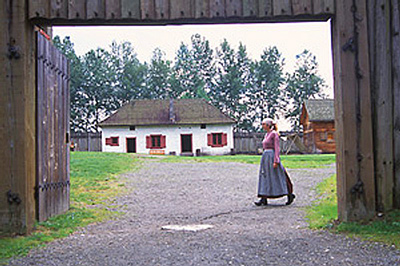Fort Langley National Historic Site of Canada
Langley, British Columbia

General view
© Parks Canada Agency / Agence Parcs Canada, J. Gordon, 2004.
Address :
23433 Mavis Avenue, Langley, British Columbia
Recognition Statute:
Historic Sites and Monuments Act (R.S.C., 1985, c. H-4)
Designation Date:
1923-05-25
Dates:
-
1839 to 1840
(Construction)
-
1839 to 1886
(Significant)
-
1827 to 1886
(Significant)
Event, Person, Organization:
-
Hudson’s Bay Company
(Organization)
Other Name(s):
-
Fort Langley
(Designation Name)
Research Report Number:
F1996-114
DFRP Number:
16574 00
Plaque(s)
Existing plaque: In front of the Visitor Centre, right of main entrance, British Columbia
Fort Langley was built by the Hudson's Bay Company 2 1/2 miles below this site in 1827, and moved here in 1839. It burned and was rebuilt in 1840. As fur resources were exhausted, supply replaced trade as the fort's major role. Here the company operated a large farm, began the west coast salmon packing industry, and exported produce to ports in Alaska, Hawaii and other Pacific areas. Fort Langley was also a terminus of the first practical all-British route from the coast to the interior. On 19 November 1858 the colony of British Columbia was here proclaimed.
*Note: This designation has been identified for review. A review can be triggered for one of the following reasons - outdated language or terminology, absence of a significant layer of history, factual errors, controversial beliefs and behaviour, or significant new knowledge.
Description of Historic Place
Fort Langley National Historic Site of Canada is the site of a Hudson’s Bay Company post located on the south banks of the Fraser River approximately 48 km east of Vancouver. It contains an original log warehouse as well as several newer evocations of historic structures within a reconstructed wooden palisade. The site is interpreted and open to the public. The official designation refers to the associated buildings and landscape within the site’s boundaries.
Heritage Value
Fort Langley has been designated a national historic site because: it was founded in 1827 to drive off the fur-traders from Boston who had monopolized the Maritime trade; it was from Fort Langley, rebuilt in 1840 (sic 1839) further up the river, that the Hudson’s Bay Company began to export salmon, supplying the forts of the Company and the Sandwich Islands (Hawaii); after the abandonment of the Columbia River as a trade route in 1848, the Company forwarded their goods to Langley for transhipment to their forts in British Columbia; and the act creating the colony of British Columbia was proclaimed at Langley in 1858.
The heritage value of Fort Langley lies in its historical associations as illustrated by the site and surviving resources. Originally constructed in 1827 at a location 4 km upstream of its present site, the post was relocated and rebuilt in 1839, only to be destroyed by fire in 1840 requiring it to be, once again, rebuilt. The Hudson’s Bay Company continued to run a post on this site until 1886, although in later years its focus shifted from fur to agricultural trade and fish packing. Since it became a national historic site in 1923 the location of Fort Langley’s palisades have been identified through archaeological investigation, as have the remains of many of its buildings and structures. The site has gone through two major periods of expansion; firstly in the 1950s in conjunction with the provincial centennial celebrations, and again in the 1990s.
Sources: Historic Sites and Monuments Board of Canada, Minutes, May 1955; Commemorative Integrity Statement, October 2003.
Character-Defining Elements
Key features contributing to the heritage value of this site include:
the siting on a small knoll above the banks of the Fraser River across from McMillan Island,
and behind a plain between the knoll and the Salmon River which provides access to Boundary Bay; its orientation to the remnants of other buildings within the fort and their central courtyard, its siting on the perimeter of the fort parallel with the palisade, the wholeness and coherence of the cultural landscape of the fort, the footprint of the palisades at its greatest extent and traces of its earlier location; the footprints as well as remnants and reconstructed profiles of buildings and structures inside the palisades of the fort; remnants of the foundations, former trenches, privies, storage pits and cellar depressions that remain on the site from the fur trade era, including their footprints and any evidence of their composition and materials; the functions and spatial relationships both individually and in relation to one another of the Storehouse building, palisade and central courtyard; the Storehouse building in its location and orientation, its single-storey rectangular massing and hipped roof; its irregular pattern of openings, surviving original materials (squared logs with a lime/mud wash), its pièce sur pièce construction technology, and remnants of early forms, finishes, and layout visible in the interior; archaeological artifacts, both above and below ground, representative of life in the fort during the fur trade era, including those that have been removed from the site and are stored by Parks Canada; viewplanes from the palisades to the Fraser River and McMillan Island, to the east, looking upriver towards the site of the earlier fort, and to the countryside and west towards the Salmon River; viewplane from the Fraser River to the fort.